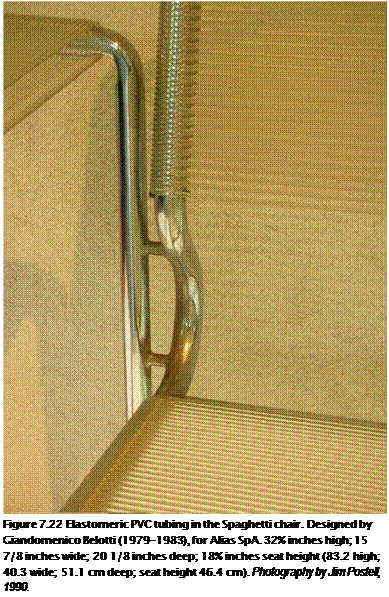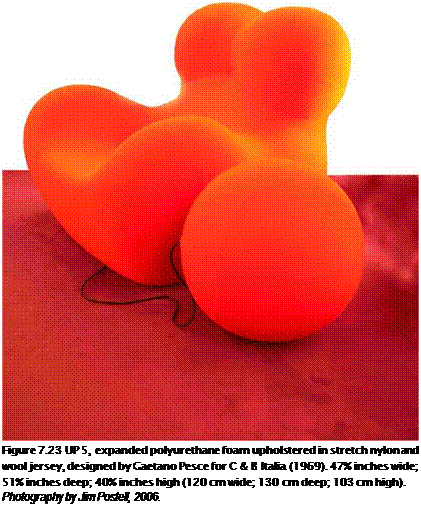A material’s ductility is its ability to be molded or shaped without breaking. Copper is a ductile metal. It folds, bends, and can be hammered or formed, as shown in Figure 7.19. Aluminum is far less ductile and is best when forged, cast, extruded, or rolled into shape (Figure 7.20). Polypropylene is a ductile polymer and can take a significant impact without breaking, especially when an elastomeric is added. Cork is a ductile wood product and is the primary material used in KorQ, a lounge chair designed by Kevin Walz in 1996 (Figure 7.21).
Durability
Relative to a material’s color, dimension, surface quality, and structural performance, most material characteristics are in a constant state of flux. Sunlight, wind, and pollution are exterior forces that influence the quality and integrity of a material’s surface. Use, wear, and maintenance also influence the physical condition of materials over time. Applied tensile or compressive forces can influence a material’s form. Considered together, exterior and interior forces complement one another, and the notion of durability engages both domains.
Durable materials such as galvanized metal, epoxy resins, and hard plastics will generally last longer than steel, organic textiles, and soft thermoplastics.
Elasticity
 A material’s modulus of elasticity is evident when deformations produced by low stress are completely recoverable after the load is removed. Giandomenico Belotti’s Spaghetti chair (1979-1983), produced by Alias, utilizes elastic PVC tubing for its seat pan and seat back (Figure 7.22). The tubing gently supports the user and returns to its original shape when the load is removed from the chair. The ability of a material to return to its original shape can offer significant potential for wide-reaching products, which include the wooden skis made of birch in the 1940s as well as the
A material’s modulus of elasticity is evident when deformations produced by low stress are completely recoverable after the load is removed. Giandomenico Belotti’s Spaghetti chair (1979-1983), produced by Alias, utilizes elastic PVC tubing for its seat pan and seat back (Figure 7.22). The tubing gently supports the user and returns to its original shape when the load is removed from the chair. The ability of a material to return to its original shape can offer significant potential for wide-reaching products, which include the wooden skis made of birch in the 1940s as well as the
memory foam pillows available today.
The modulus of elasticity (Young’s modulus) is a material parameter that describes the relationship between stress and strain when a solid body is subjected to external force. A material with a high modulus of elasticity is considered rigid and will resist deformation, while a material with a low modulus of elasticity will appear pliable when under stress or applied force.
Expandability
Expandable polyurethane is a material that expands when exposed to air for the first time. Gaetano Pesce used this material in his UP series chairs (Figure 7.23). The UP series consists of seven models of sofas and armchairs of different sizes. The chairs were shipped by the manufacturer, compressed in a thermo-sealed vacuum container at 10 percent of their actual size. When they were unsealed, the foam expanded back to its
original size and gained full form approximately one hour after the seal was broken.

 Most materials (except for thermosetting plastics) expand with either heat or moisture. Metal expands when heated. Wood and leather expand when moisture is increased. Thermoplastics (polymers) expand when heat is applied. Fabric and rubber deform when tensile forces are applied.
Most materials (except for thermosetting plastics) expand with either heat or moisture. Metal expands when heated. Wood and leather expand when moisture is increased. Thermoplastics (polymers) expand when heat is applied. Fabric and rubber deform when tensile forces are applied.



